#Picos de Europa National Park
Explore tagged Tumblr posts
Text










Forest (No. 103)
Picos de Europa National Park, E
#Naranjo de Bulnes#travel#original photography#vacation#tourist attraction#landmark#architecture#Southern Europe#summer 2021#landscape#countryside#woods#forest#nature#flora#Spain#España#Picos de Europa#Cantabrian Mountains#clouds#Picos de Europa National Park#Picu Urriellu
66 notes
·
View notes
Text


The Lakes of Covadonga, Picos de Europa National Park, Asturias, Spain
Manuel Torres Garcia
#The Lakes of Covadonga#Picos de Europa National Park#Asturias#Spain#National Park#SpainNature#Cows#Cow#SpainWildlife
2 notes
·
View notes
Text

Picos de Europa National Park above the clouds (Asturias, Spain).
#nature#mountains#picos de europa#nationalparks#national park#nature hikes#mountain hike#girls who hike#hike#day hike#a short hike#take a hike#hikers
9 notes
·
View notes
Text
my great grandfather was born in 1903 and died in 1989 which means he lived through:
the rule of alfonso xiii (1901-1923)
the melilla war and the tragic week (1909)
the creation of the spanish protectorate in morocco (1912)
wwi (1914-1918)
the institution of the first national parks (picos de europa and oropesa) (1918)
the inauguration of the madrid metro (1919)
the dictatorship of primo de rivera (1923-1929)
the 'dictablanda' (soft dictatorship) of berenguer (1930)
the second spanish republic (1931-1936)
the spanish civil war (1936-1939)
the dictatorship of francisco franco (1939-1975)
wwii (1939-1945)
spain enters the un (1955)
the independence of morocco (1956)
the palomares incident (1966)
eta starts doing terrorist attacks (1968)
the carrero blanco assasination <333 (1973)
franco dies (1975)
the transition to democracy under king juan carlos i (1975-1981)
the failed coup of tejero (1981)
the statute of autonomy of castilla-la mancha (where he's from) (1982)
decriminalization of abortion (1985)
spain enters nato and what would be the eu (1986)
he died during felipe gonzález's presidency (there were elections in 1989 and he won, starting his third term that year)
5 notes
·
View notes
Text
Spain 2023
5/7/23
Another warm day, albeit a bit cloudier than Tuesday, so decided we ought to explore the mountains for a bit. We did visit the beach of Vega, which is part of the dinosaur trail and saw some interesting Jurassic rock formations before having a coffee at a beachside cafe and then set off to explore the Picos De Europa national park. Our first stop was a viewpoint called Mirador del Fito which is over 1100 metres above sea level and would have afforded great views - were it not for the fact that it was completely surrounded by low cloud making any photos pointless! However we did enjoy the cows and their cow bells in the car park who were very entertaining!
After this disappointment we drove further into the mountains following the river Sella which is renowned for its canoeing. We stopped first of all for lunch at Arriondas where a lot of the canoes set off from and then on to Cangas de Onis which was a very attractive town with lots happening. After a quick tea and cake we moved onto Covadonga and in particular it’s basilica, which is a key place of worship for the people of this region. Next to it is a sacred cave where the remains of a ancient king Pelayo are buried. It’s all very impressive, in particular, its location high up the mountains.
On our way back to our hotel we decided to detour to the Mirador del Fito on the off chance that the clouds had lifted - and low and behold- they had, so we were able to see all the way down to our resort of Ribadesella and further along the coast. It was well worth it!
After quite a tiring day we kept in simple in the evening and went into town for some excellent tapas which we ordered in Spanish. In fact we are almost fluent now I reckon!!










5 notes
·
View notes
Note
I would love to know how you chose your name! Please do share
ksksksk hello rainbow! With this I will finally beat the hetalia accusations and will be able to resume my honourable life, writing smut.
I accidentally named myself after a leather tag on a pair of fuzzy pink novelty socks that I bought after a hike through Picos during which my worn in black converse were so wet with snow that I lost sensation in all my toes. This was incidentally less than 24 hours after I pulled a 32 hour no-sleep stint and travelled from Scotland to Spain (where i climbed up the aforementioned Picos de Europa National Park in my converse although admittedly i also rode the cable car up most of the way). During this 32 hour no sleep stint I had a half-hallucinatory but also deeply reflective experience standing in front of a triptych in the Guggenheim titled something like a Christ allegory. in the span of those 32 hours I also crossed from one autonomous region to another, learned about an eviscerating family secret and also stepped foot near my grandmother's home town unawares of the fact that she would die three months later, followed by another three family tragedies.
Some years later, I thought about naming myself something with the same general vibes as 'Armand'; shortly thereafter i chose Antonio. It was the most correct choice. One night i was wearing my fuzzy pink socks in the middle of the pandemic and realised that they have small leather tags with 'Antonio' printed on them. i laughed in my dark empty flat and told some of my very dear friends on Telegram. I choose to keep the male form of my deadname as a second given name because men in my family have compound names and I like the way it sounds. i go mostly by my first name.
One day, a friend asks if I named myself after Antonio from Hetalia.
Some months after that, I'm watching WWDITS with a friend and we crack up when Guillermo explains how much he loved Armand from VC; they show him in his wee costume and my friend asks teasingly if i named myself after Antonio Banderas because Armand sounds out of place in the modern world. I open my mouth to defend myself but it is too late, she is already laughing.
The truth is that I simply chose Antonio because i liked it. San Antonio is the patron saint of lost things and impossible love.
#freagradh#you might be thinking honey it has been three days#you are right it has i was sleeping dancing and committing a general array of shenanigans#i also finished my prelim literature review#i am still vaguely dumbed down with exhaustion ksksks please enjoy the story of how i chose my name
5 notes
·
View notes
Text
Luxury Travel To Spain: Your Gateway to Elegance
Spain, often considered the heart of Europe, is a land steeped in enchantment and history. It is where ancient marvels whisper their tales to anyone willing to listen, and where every cobblestone street hides secrets of the past. Embark on a journey through Spain, a mesmerizing world of ancient wonders that continue to resonate with the echoes of time. Is discovering unique natural spaces a highlight of your trips? Then you need to get to know the impressive options Spain has to offer.

Are you yearning for an opulent escape to Spain that transcends the ordinary? Look no further than Europa World Travels, a Madrid-based boutique Destination Management Company (DMC) that specializes in curating exquisite journeys to Spain, Portugal, and Morocco. If you’re seeking a seamless blend of luxury and authenticity, their expert team is ready to craft an unforgettable experience that caters to your every desire. Europa World Travels, recognize that true luxury lies in the details. From the moment you entrust us with your dream getaway, their expert team goes to work. They will plan every aspect of your journey meticulously.
Discover Spain: A Land of Wonders
A Tapestry of History and Culture
Spain's history is a mosaic of influences from various civilizations, including the Romans, Moors, and Visigoths. This rich heritage is reflected in its architecture, art, and traditions. The Alhambra in Granada, a stunning example of Moorish architecture, and the Roman aqueduct in Segovia are just a few of the ancient wonders that transport visitors back in time. Wander through the narrow, cobblestone streets of medieval towns like Toledo and Salamanca, where every corner reveals a piece of Spain's storied past.
Vibrant Cities
Spain's cities are a vibrant blend of old and new, offering something for every traveler. Barcelona, with its whimsical Gaudí architecture and bustling Las Ramblas, is a feast for the senses. Madrid, the capital, boasts world-class museums like the Prado and the Reina Sofia, as well as a dynamic nightlife scene. Seville, with its flamenco rhythms and grandiose cathedral, captures the essence of Andalusian culture. Each city has its unique charm, inviting visitors to immerse themselves in its rhythms and flavors.
Natural Beauty
From the snow-capped peaks of the Pyrenees to the golden beaches of the Costa del Sol, Spain's natural landscapes are as diverse as they are breathtaking. The Picos de Europa National Park offers rugged beauty and adventure, while the serene landscapes of the Canary Islands provide a tropical escape. Spain's coastline, with its azure waters and hidden coves, is perfect for both relaxation and water sports.
Culinary Delights

Spanish cuisine is a celebration of flavors, with each region offering its specialties. Indulge in tapas in the lively bars of Madrid, savor paella by the coast in Valencia, or enjoy pintxos in the Basque Country. Spain's culinary scene is diverse and innovative, with a strong emphasis on fresh, local ingredients. Don't miss the chance to sample Spain's world-renowned wines, from the robust reds of Rioja to the sparkling cavas of Catalonia.
Warm Hospitality:
Spain is known for their warm and welcoming nature. You'll feel like a cherished guest as you explore the country's cities and countryside. Europa World Travels prides itself on crafting tailor-made itineraries that cater to your preferences. Their dedicated travel consultants take the time to understand your interests, desires, and expectations, ensuring that every aspect of your journey aligns with your vision of luxury.
Exclusive Accommodations
A journey to Spain deserves exceptional accommodations. Europa World Travels can select the most exquisite hotels, resorts, and villas for you. Whether you seek the historic charm of a boutique palace hotel or the modern elegance of a resort, they are the perfect match for your taste.
Seamless Travel
Your Luxury Travel in Spain should be a stress-free indulgence. With Europa World Travels, every aspect of your trip, from transfers to guides, is meticulously planned and flawlessly executed. They never let you worry about it except relishing the moment.
Embark on Your Luxury Travel to Spain Today:
Whether you're exploring ancient ruins, indulging in culinary delights, or soaking in the vibrant atmosphere of a festival, Spain promises to captivate and inspire. Pack your bags and set off on an adventure to discover the magic of Spain—a journey that will leave you with memories to treasure for a lifetime. Europa World Travels takes pride in transforming your travel dreams into an elegant reality. Whether you're planning a romantic escape, a family adventure, or a solo exploration of Spain, let the incoming travel agency for Spain - Europa World Travels be your guide to the extraordinary.
0 notes
Text
Cantabrian Mountains
View of mountains of Picos de Europa National Park from Cable viewpoint. Photo by Carlos Bruzos Valin. The Cantabrian Mountains, also known as the Cordillera Cantábrica, are a breathtaking mountain range that stretches across northern Spain, captivating the hearts of nature enthusiasts and outdoor adventurers alike. This awe-inspiring landscape, sculpted by the forces of nature over millions of…
0 notes
Text
From Beaches to Mountains: Spain’s Top Outdoor Adventures

Spain is a treasure trove of natural wonders, offering endless opportunities for outdoor adventures. Whether you’re drawn to its golden beaches or majestic mountains, the country is a haven for nature lovers and thrill-seekers alike.
Coastal Adventures
Spain boasts some of the most stunning beaches in the world, perfect for water-based activities. The Costa Brava, with its crystal-clear waters and hidden coves, is a must-visit for kayaking and snorkeling enthusiasts. Further south, the Costa del Sol offers a vibrant atmosphere for jet skiing and parasailing. For those planning a move, check out relocation services in Spain to ensure your transition is seamless and stress-free.
Hiking in the Mountains
The Spanish Pyrenees and Sierra Nevada are paradise for hikers and nature enthusiasts. Trails range from beginner-friendly paths to challenging routes for experienced adventurers. Along the way, you’ll discover breathtaking landscapes, charming villages, and unique wildlife. If you’re relocating to Spain, trusted relocation companies in Spain can help make your move effortless.
Cycling Adventures
Spain is a top destination for cycling, with its varied terrains catering to all skill levels. Explore the rolling hills of Andalusia or take on the challenge of the Vuelta a España routes. The country’s cycling trails combine stunning scenery with thrilling experiences.
Rock Climbing and Caving
For adrenaline junkies, Spain offers excellent rock climbing spots such as El Chorro and Montserrat. Additionally, caving enthusiasts can explore the underground wonders of Picos de Europa and Cueva de Nerja.
Exploring National Parks
Spain’s national parks, like Doñana and Ordesa, provide unique ecosystems to explore. From lush forests to dramatic cliffs, these parks showcase the country’s incredible biodiversity.
Conclusion
Whether you prefer the sun-soaked beaches or the cool mountain air, Spain has something for everyone. Embrace the thrill of outdoor adventures and discover the beauty of Spain’s diverse landscapes. With the right relocation services in Spain and expert assistance from relocation companies in Spain, your move will be as exciting as the adventures that await you.
0 notes
Text
Spain’s Princess Leonor marks special moment for little village of Sotres
The Princess of Asturias, the heir to Spain’s throne, visited on Saturday the most exemplary village of Asturias, surrounded by King Philip VI, Queen Letizia and Infanta Sofia.
The day after the award ceremony of the Princess of Asturias Foundation, Princess Leonor continues her annual stay in the north-west of the country, visiting a town that has received the title of “Model Village of Asturias.” This year, the village of Sotres, located at the highest altitude of the Picos de Europa National Park, received this title.
Princess Leonor, 18, took her family to this village, located in the municipality of Cabrales. On site, King Philip VI, Queen Letizia, Princess Leonor and Infanta Sofia met with local authorities, the population and visited certain businesses and emblematic places. The village received this award thanks to the conservation of the place, its traditional heritage and activities based on sustainable development. The village also has a food industry and quality tourism.
The Sotres Neighbourhood Association was established in 2006 to protect the interests of its inhabitants and preserve their traditions and heritage. In recent years it has developed remarkable activities, especially encouraged by young people. Among the projects implemented by the neighbourhood association is the Sotres Cultural Festival. The association has also restored the old village schools that had been closed down. They are now used to organise other activities such as yoga classes or language courses.
The royal family, accompanied by Cabrales Mayor José Sánchez, travelled to the mountain goat pastures and then to the drying cave where cheeses are made. Throughout the visit, Princess Leonora was warmly welcomed by the population to the sounds of traditional music performed by folklore groups.
The day’s visit ended with a speech by Princess Leonor, who this year celebrates her 10th anniversary as Princess of Asturias:
“I have read a lot about Sotres, the last town of Asturias, which is so high up. It is a magnificent place in the heart of a national park, within a biosphere reserve and a protected natural area, but it is so much more than that: this city is you.”
Read more HERE

#world news#news#world politics#europe#european news#european union#eu politics#eu news#spain#spain 2024#princess leonor#royal family#royalty#sotres#king philippe
0 notes
Text










Forest (No. 104)
Picos de Europa National Park, E (five pics)
Rionansa, E (five pics)
#Naranjo de Bulnes#travel#original photography#vacation#tourist attraction#landmark#architecture#Southern Europe#summer 2021#landscape#countryside#woods#forest#nature#flora#Spain#España#Picos de Europa#Cantabrian Mountains#clouds#Picos de Europa National Park#Picu Urriellu#Rionansa#Cantabria#mountain village
24 notes
·
View notes
Text
Spain: Unveiling the Land of Flamenco and Tapas

Spain, the land of rich history, vibrant culture, and enchanting landscapes, has long been a favorite destination for travelers around the world. From the bustling streets of Barcelona to the serene countryside of Andalusia, Spain offers a diverse array of experiences that cater to every kind of traveler. In this comprehensive travel guide, we'll walk you through the essential aspects of preparing for your Spanish adventure, from securing a visa to exploring the best places to visit, whether you prefer the bustling cities or quaint countryside. We'll also offer insights into transportation options, accommodation choices, and tips for adventurous souls who want to trek and camp in Spain's beautiful wilderness.
Preparation Before Visiting Spain:
Before setting off on your Spanish adventure, it's crucial to ensure you have all the necessary documentation. If you're a citizen of the European Union, you won't need a visa to enter Spain, but other international visitors will. To obtain a tourist visa, you'll typically need a valid passport, proof of accommodation, a return flight ticket, and evidence of financial means to support your stay. Be sure to check the Spanish consulate or embassy in your home country for specific visa requirements and application procedures.
Places to Visit in Spain:
Spain boasts a plethora of iconic destinations. Barcelona beckons with its architectural marvels, including Antoni Gaudí's Sagrada Familia and Park Güell. Madrid, the country's capital, is a treasure trove of art, culture, and history, with attractions like the Prado Museum and the Royal Palace. Seville, Granada, and Cordoba in Andalusia offer a taste of Spain's Moorish past and stunning architectural wonders, such as the Alhambra. Don't forget to explore Valencia, San Sebastian, and the beautiful beaches of Costa del Sol. Each city and region in Spain has its unique charm, making it a diverse and captivating destination.
Places to Visit in Small Towns and Countryside:
While Spain's cities are captivating, its small towns and countryside are equally enchanting. Explore the historic streets of Ronda, stroll through the white-washed villages of Andalusia like Mijas and Ronda, or lose yourself in the medieval wonder of Cuenca. The Spanish countryside offers breathtaking landscapes, from the rolling vineyards of La Rioja to the rugged terrain of Picos de Europa National Park. To truly immerse yourself in Spain's rural beauty, consider visiting the Pyrenees, where you can explore charming villages and stunning mountain scenery.
Traveling by Personal Vehicle or Public Transport:
Whether to travel by personal vehicle or public transport in Spain depends on your preferences and itinerary. In major cities like Barcelona, Madrid, and Valencia, public transportation, including buses and subways, is efficient and convenient. For traveling between cities, Spain's high-speed train network (AVE) is an excellent option. However, if you plan to explore the countryside extensively, renting a car may provide more flexibility. Spain's road network is well-maintained, and scenic routes are abundant.
Booking Accommodation:
Accommodation options in Spain range from luxury hotels to budget-friendly hostels and unique experiences like couch surfing. Websites and apps like Airbnb, Booking.com, and Hostelworld make it easy to find accommodation that suits your budget and preferences. If you're looking for budget-friendly options, consider staying in "pensiones" or "casas rurales" in small towns, and if you're feeling adventurous, explore the world of couch surfing for a more immersive experience.
Renting a Vehicle as a Tourist and Traffic Rules:
Renting a vehicle as a tourist in Spain is straightforward. Major international car rental companies have offices at airports and cities. To rent, you typically need a valid driver's license, a credit card, and must be at least 21 years old. Remember to drive on the right side of the road, obey speed limits, and always carry your driver's license, passport, and rental documents. Spain enforces strict anti-drunk driving laws, so avoid alcohol when driving.
Hiking and Solo Camping:
Spain offers incredible opportunities for hiking and solo camping. The Camino de Santiago is a famous pilgrimage route that spans the entire country. If you're a fan of coastal beauty, the Costa Brava's rugged trails are perfect. Inland, explore the Sierra de Grazalema or Picos de Europa for stunning mountain landscapes. While camping is permitted in some areas, it's essential to check local regulations and obtain any necessary permits. Always leave no trace and respect the environment.
Applying for an International Driving License in Spain:
If you plan to drive in Spain and your driver's license is not in Spanish or another EU language, you may need an International Driving Permit Spain (IDP). You can apply for an IDP in your home country before your trip. It's a good idea to have one even if it's not always required. It will ensure that you can drive with confidence and ease throughout your Spanish adventure.
As you embark on your journey to Spain, keep in mind that this guide is just the beginning. Spain is a country of endless discoveries, where each corner holds a new surprise. So, pack your bags, secure your visa, and get ready to savor the flavors, history, and culture of Spain – it's a travel experience you won't soon forget.
0 notes
Text
Exploring Northern Spain (modified)
I am writing this on the evening of September 22 from our last destination of this planned trip, Oviedo, Spain. We have two days here before we leave for a trip with Annie & Carl to Brittany, France. I'm afraid my social life has gotten in the way of my journaling - so tonight I'm staying in and writing. It is NOT like I am cloistered though, we are in the center of the city and currently a marching band is passing our hotel. Mark is trying to figure out if this is just a Friday event or a pre-football event. Real Oviedo is playing Langroe tomorrow - and I know y'all know this is NOT pointy ball football but the real thing. Anyway it is awesome.

This is pretty much our route with mini variations as we have veered off to see this or that amazing thing. Today we went went through Picos de Europa National Park. We are in España Verde (Green Spain) and it is simply beautiful. Here is a bigger shot of our route. Our eastern most point was San Sebastian or Donostia as it is called in the Basque language. That is what I will talk about today.
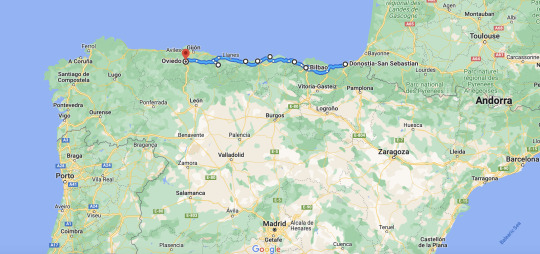
Sept 19, 2023
San Sebastian or Donostia
What an absolutely gorgeous place!!
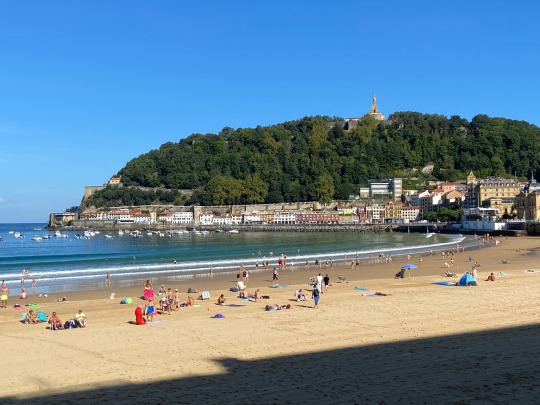

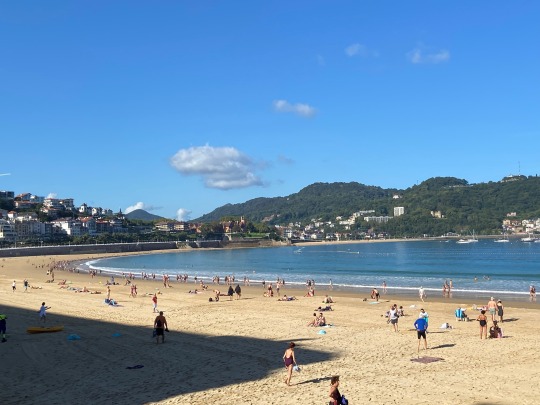
This beach is protected on 3 sides by land (the beach is like a clam shell) and people swim here year round - although this is the North Atlantic. This place was was Queen Isabella II can 3 times a year to bathe to address her skin condition. Now - I'm going out on a limb here - but truly she bathed ONLY 3 times a year. I'm guessing had she bathed - let's just say once a month or every other week - or gods forbid DAILY - her skin condition would have gone away. But that is just me...
This might be a good time to talk about the Spanish Royals. Let me just say - What the hell?
Spain has a constitutional monarchy - like Great Britain. But there are a few differences.
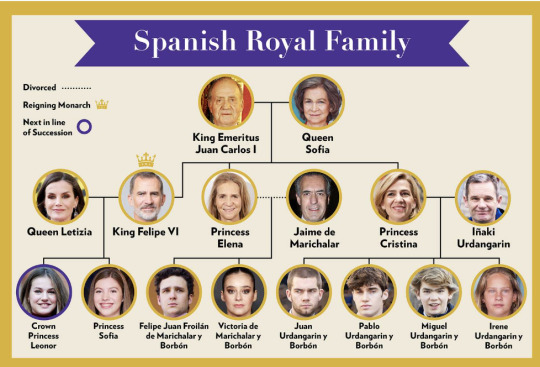
Before the death of Franco, he had hand-picked his successor someone who would carry on his vision of Spain as a deeply conservative Catholic country, and thought he had found that person in Juan Carlos I, a member of the Spanish royal family. (His grandmother was the granddaughter of Queen Victoria.) In 1969, he named Juan Carlos as his successor, certain that the future king would keep Spain on its authoritarian path. But Franco badly misjudged his chosen successor. After the dictator’s death, Juan Carlos turned out to be a reformer. The constitution was rewritten, Spain transitioned to a democratic system, and elections were held soon after. Due to lots of issues Juan Carlos 1 - decided that this dictator of a Catholic nation was not really his gig - so he decided to be king instead and slowly transitioned the country to democracy. But even after passing laws saying every person was equal under the law EXCEPT the king, he realized he was not going to be free for long - so June 19, 2014, he abdicated while he had a parliament that was pro-monachy and would accept his son Felipe as king. Felipe is King and Juan Carlos is in exile - without the queen - who has had it with his shenanigans.

And the photo below is the queen and crown princess congratulation the women of the Spanish team after winning the World Cup this year. ( Notice - no kissing here)

With no male heir, Leonor, Princess of Asturias born 31 October 2005) is the heir presumptive to the throne of Spain as the elder daughter of King Felipe VI and Queen Letizia.
FYI - we are in the region (think state) of Asturian tonight. Just like the crown prince/princess of Great Britain is the Prince of Wales - in Spain the crown prince/princess is the Prince/Princess of Asturia
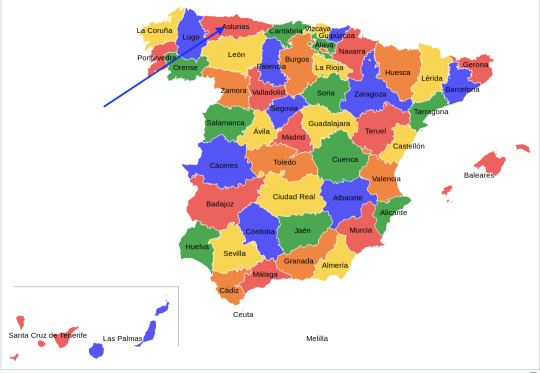
Enough about that. Back to San Sebastian or Donostia .
After Queen Isabella II decided it was "fashionable" to bathe, the trend was established and the who's who of money followed. It became all that - AND a bag of chips - so many historical figures dipped their toes in the water. People like Leon Trotsky and Mata Hari come to mind.
This town is know for its food and I could not fail to mention the Txokos, or private male gastronomic societies that characterize Basque culinary culture. These men cooking clubs are now accepting women - but they are forbidden to enter the kitchen. Sounds like something I would like.
If you can get an invitation you can expect to enjoy things like bacalau (salt cod) with browned garlic olive oil emulsion and piperade (basque pepper sauce), kokotxas (cheeks of hake fish), langoustine with serrano ham, and hard cider in the company of the other men who are members of the society.
We had these items in different restaurants but no doubt the men's club food would have been better.
This city has had some tragedies. It was a hot bed of fighting during the Civil War
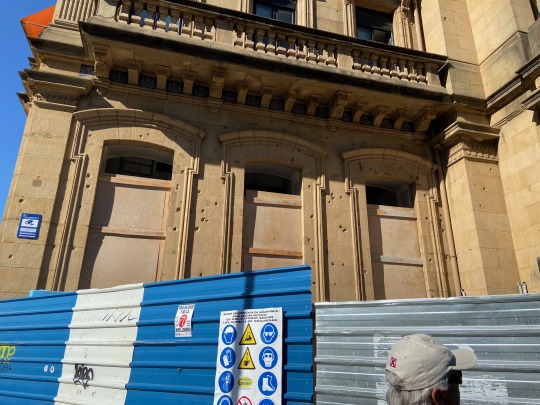
From the city's website:
"31st August of the year eighteen thirteen – a date marked in red in the history of San Sebastián. On that day, blood and fire tainted the streets of our city, raising it to the ground. A huge civilian tragedy to which this building bore witness.
These were the years of the Peninsula War that pitched Spain against France. San Sebastián was under the control of the French army at that time. The Anglo-Portuguese Alliance, which had become involved in the war to support Spain, had started to gain the upper hand over Napoleon Bonaparte’s army. In the summer of that year, English troops, backed up by Portuguese soldiers, besieged the city of San Sebastián. On the morning of 31st August, troops led by General Sir Thomas Graham, who was acting on orders from the Duke of Wellington, managed to breach the defences and enter the city. The French troops, who were completely overcome, withdraw to Mt. Urgull, seeking to protect themselves inside the La Mota castle.
The locals endured a succession of unmentionable atrocities. Under the pretext that San Sebastián sympathised with French interests, English soldiers fired their guns the whole day at balconies and windows, gained access to houses and seized everything of value. The vandalism and looting spread throughout all the streets, houses and churches. As in all wars, many women were raped, and hundreds of locals were shot dead: children, the elderly…. nobody was safe. Ultimately, they set fire to the whole city.
The huge fire reduced practically all houses to cinders in the old city. This building, below (San Sebastion Cathedral) is one of the few that remained standing and is the only one to maintain the façades and construction elements typical of the time."

Not much remained. The city was built back in standard at-the-time construction so the old town looks pretty uniform today. I was however intrigued by this:
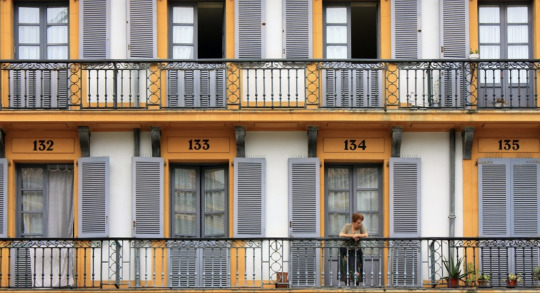
This is the city square and during the Franco times, these homes faced the bull fighting arena. You may own your home - but the city owned your balcony and for event - like a bullfight - the city sold tickets to your balcony. Hmmmm..

We loved this place and enjoyed every minute there including this beach art. Sadly it will be gone in about 5 hours. But for now, it was awesome.
I snapped a picture of this guy in a store window:
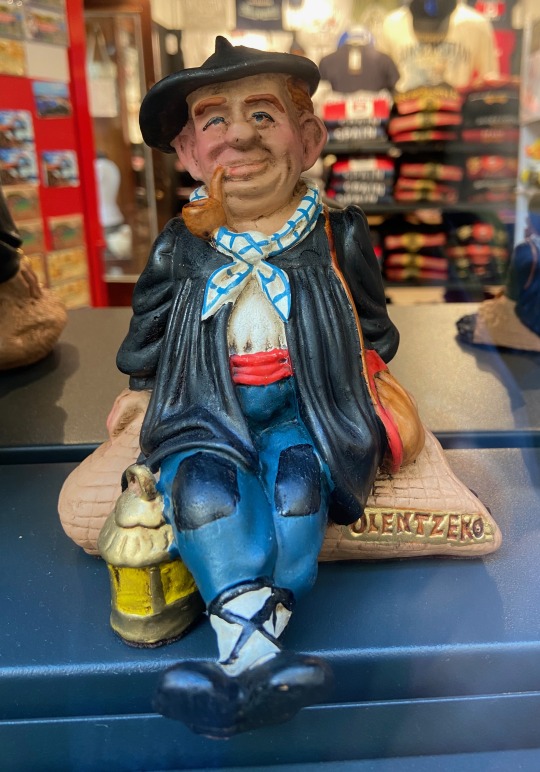
¡Eguberri on! (Happy Christmas in Basque)
This is Olentzero
Some historians believe Olentzero's origins can be traced back to pre-Christian Navarre and are linked to pagan winter solstice traditions, although the character was later adapted to conform with Catholic rituals
The story goes that Olentzero began his life as an abandoned infant who is found by a fairy godmother.
After bestowing the child with the gifts of “strength, courage, and love," the fairy leaves him with a childless couple who raise him as their own in the foothills of the Pyrenees.
Olentzero whittles wooden toys and at Christmas comes down from the mountains to the villages to distribute his crafts among the children.
Then one day as he is taking the gifts to a nearby town he passes a house that is engulfed in flames and charges in to save all the children inside. After performing this heroic deed, however, he perishes in the flames.
But his fairy godmother grants him eternal life so that he can continue to make toys for all the Basque children.
So - a couple of things: Olentzero has been cleaned up a bit over the years. Now he is a pipe-smoking jolly drunk filled with love. But 100 years ago, he would come to your house and leave a gift IF you had been good BUT if you had been bad - he would slit your throat. Talk about some motivation to mind to your parents - hey?
This character and the celebration that welcomed him were banned under Franco's rule. Catholicism was required so only the "approved" Catholic way of celebration Christmas were allowed. Below is a photo from 1930 Pre-Franco times:

Did you know that under Franco rule parents had to name their children Franco approved names? And no Basque names made the list. If you were on the Franco team - times were good (unless you pissed him off). On the side against Franco - not so good.
After lunch we headed back to Bilbao for our afternoon at the Guggenheim Museum. But you already know about that - so tomorrow I will write about Castro Urdiales and Santander. Loving Northern Spain.
Stay tuned.
0 notes
Text

🙋 Nos despedimos del Refugio de Collado Jermoso y emprendemos etapa al Refugio de Cabrones en Picos de Europa National Park.
https://trekkinea.com/
#trekkinea#viajesdeaventura#guiastrekkinea#rutasdemontaña#viajesengrupo#guiasdemontañauimla#trekkingtime#trekkinglovers#adventure#guiasdemontañapicosdeeuropa#picosdeeuropa#hiking#mountains#mountainadventures#viajesdemontaña#viajessingles#viajesdeportivos#travelmountain
1 note
·
View note
Text
Getting to Know Spain's most Enchanting Medieval town
Explore the #Medieval Beauty of #Spain: An Insider's look at the most enchanting town in the country. #diversity #inclusion #storytelling
Welcome to Potes, a beautiful medieval-style town in Cantabria, Spain. This charming town is a hidden gem in the Picos de Europa National Park, surrounded by stunning landscapes and beautiful mountains. It is a perfect destination for those who want to experience a mix of history, culture, and nature. Cultural History Potes dates back to the Roman period, and its medieval architecture reflects…

View On WordPress
0 notes
Photo

Picos de Europa National Park. https://southolespaintours.com/picos-de-europa/ #spain #southolespaintours #northernsain #cantabria #cantabriainfinita #asturiasparaisonatural #asturias #holidays #travel #travelblogger #spaintravel #alwaysgo #travelgirlsgo #wanderlust...
0 notes